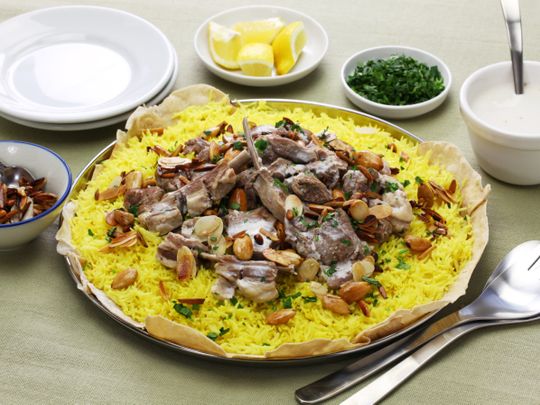
Dubai: The Middle East is a vast and diverse region in which Arab culture has mixed with — over the generations —local Levantine, Berber, Armenian, Kurdish, Turkish and Persian cultures.
The Ottoman Empire also ruled over large stretches of the Middle East for hundreds of years, leaving a deep cultural impact on the local populations.
As a result, many of the cuisines of these various countries are shared or are similar, often with slight variations depending on the country’s local preferences and produce.
I myself am Lebanese, married to a Syrian, and I have friends from Palestine, Egypt and Algeria.
At the risk of sounding biased, I just can’t get enough of Middle Eastern food, mainly because many of the dishes contain olive oil and garlic, which are delicious, but also because I find the dishes to be very healthy, with many vegetarian options.
I have selected 11 dishes from around the region that I think represent important staples in Middle Eastern cuisine.
Some are super easy to make while others require some intensive labour and preparation.
I am a working mum, and do not have time to make elaborate dishes often.
I opt for the easiest way to make these dishes, but you can always make them with fresh ingredients instead of going for cans from stores.
Hummus
Hummus is a spread or dip made with chickpeas, olive oil, garlic, tahini, lemon juice and salt. Sometimes it has other added ingredients, like red pepper, pine nuts, or butter depending on the country.
It is a dish with origins in the Levant — a region that includes Lebanon, Syria, Palestine, Jordan and Turkey — due to the abudnance of chickpea agriculture. It is practically guaranteed if you are invited to a Levantine dinner that this will be present on the table.
The question ‘who invented hummus?’ can probably erupt into a heated argument if you ask a group of Middle Easterners. What is for certain, however, is the dish is not Israeli — as many attempt to claim.
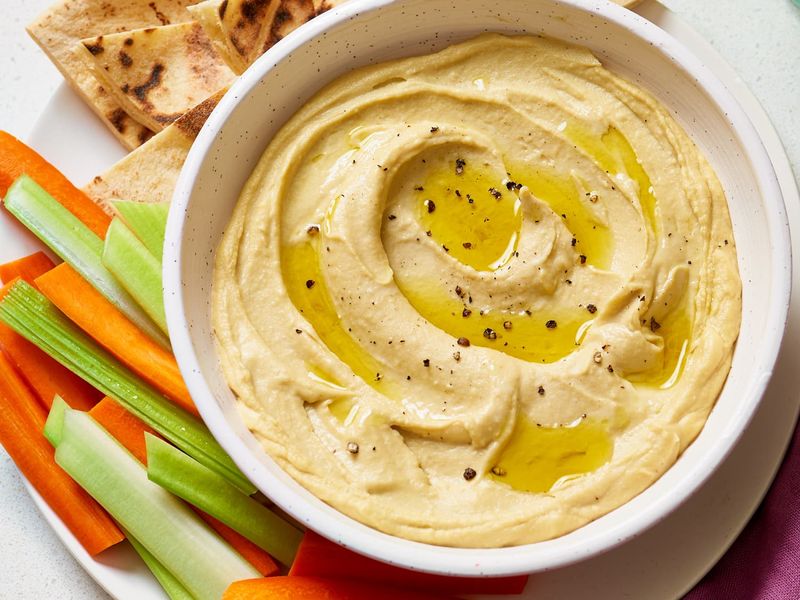
Palestinians accuse Israelis of appropriating their culture and food and argue that there is no such thing as Israeli food as most Israelis are simply Jews who emmigrated to Palestine from Eastern Europe and Russia.
Another interesting fact about Hummus is that some health experts consider it to be an aphrodisiac because it is packed with iron, magnesium, zinc, and potassium, all known to aid in sexual functions and boost physical energy.
It has become hugely popular the United States — particularly within the vegetarian/vegan communities because it is so healthy and considered an energy booster.
Some popular coffeehouse chains even offer this up on the menu as an appetizer, often served with baby carrots on the side.
How to make hummus:
Ready-to-eat hummus is available in cans, but I never really liked the taste. The good news is it is simple and easy to make at home.
I always have a bowl of fresh hummus in my fridge in case I want a quick snack. While there are many versions with slight differences, here is what I do:
1) I take one can of store-bought chickpeas and dump it into my blender
2) I add 1/2 to 1 clove of crushed garlic
3) I squeeze an entire lemon and add it to the mix
4) I add 1 tablespoon of salt
5) 4 tablespoons of tahini (sesame paste)
6) And just mix it! Add water if you want a more fluid consistency
Manakeesh
The ‘K’ is silent. Manakeesh is also a popular Levantine food, usually eaten for breakfast with a steamy cup of tea on the side. It is basically flat bread baked in the oven with either cheese, za’atar (dried thyme) or ground meat.

If you are in Lebanon, Syria, Palestine, Jordan or Turkey this will be widely available on practically every street corner — fresh and piping hot from the oven.
You can eat it on the go if you are in a hurry or if you are preparing it at home, serve it up with sliced tomatoes and cucumbers on the side.
Again, it is impossible to track down the exact origins of the dish as the Levantine countries were once all under the Ottoman Empire, in which trade and migration were constant themes.
How to make manakeesh:
5 cups strong pizza flour (if you can, otherwise, all purpose white flour will do)
3/4 cup vegetable oil
1 and 3/4 cups water
2 tspns salt
2 tspns sugar
1 tbspn yeast
Toppings add either white cheese or 1/2 cup za'atar mixed with olive oil
Just bake!
Foul Medames
Cooked fava beans served with vegetable oil, cumin, and optionally with chopped parsley, garlic, lemon juice.
Some also choose to add toppings like tomatoes, onions, chili pepper, or even a splash of clarified butter or extra fat.
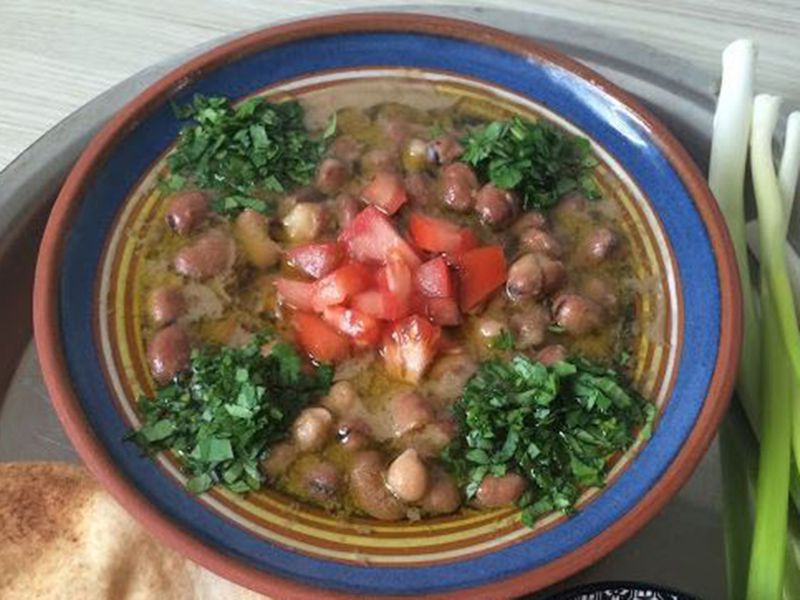
Remnants of foul medames were uncovered in a number of the 12th Dynasty (1991-1786 B.C.) Pharonic tombs in Egypt.
This dish is one of the most common and popular forms of Egyptian street food, and probably the country's national dish. It is also a common part of Levantine, Arab and African cuisines as well.
This is typically a breakfast food, but it is best eaten during the weekend when you can take a nice nap afterwards, as the dish often makes you feel very full, sleepy and lethargic.
Here is how I make foul medames:
I boil a can of store-bough foul medamas and add one clove of crushed garlic, olive oil, lemon and salt to taste. I chop parsley and tomatoes and add it to the mix and I eat it with pita bread.
Falafel
Falafel, a staple Middle Eastern dish — and a popular street food around the world — consists of fried spiced balls or patties of ground chickpeas or fava beans (or a mixture of both) stuffed into a pita or wrapped in laffa bread with hot sauce, tahini sauce, and generally some salad-like combination of tomato, lettuce, cucumber, onion, parsley, and yogurt.
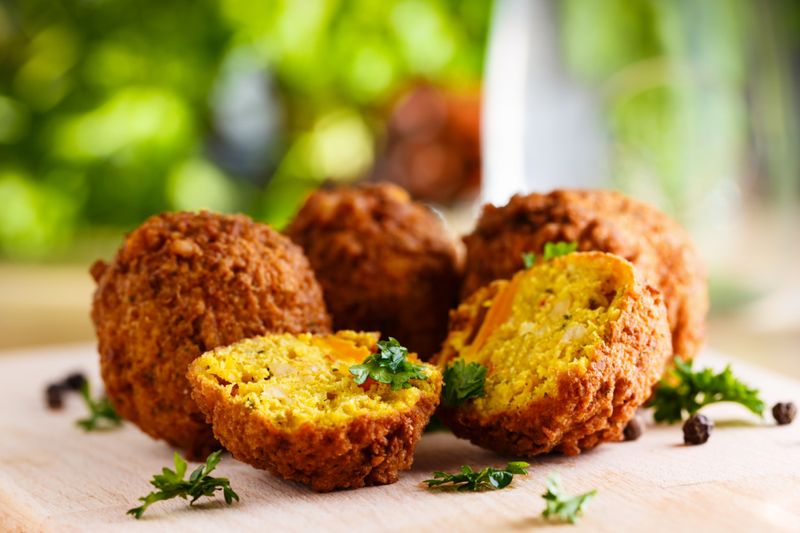
This is yet another Middle Eastern food appropriated by Israel. It is peddaled in America as “Israeli food” but in Europe it is often sold by Arabs and Turks.
I have never made falafel from scratch as it always seemed intimidating to me.
But if you are ambitious and want to try there are tons of available recipes online to look up.
Tabouleh
This is for parsley lovers. The special Levantine salad made from parsley, onion, tomatoes and burghol (cracked wheat) is considered Lebanon’s national food, and is said to have originated in the mountains of Lebanon and Syria.
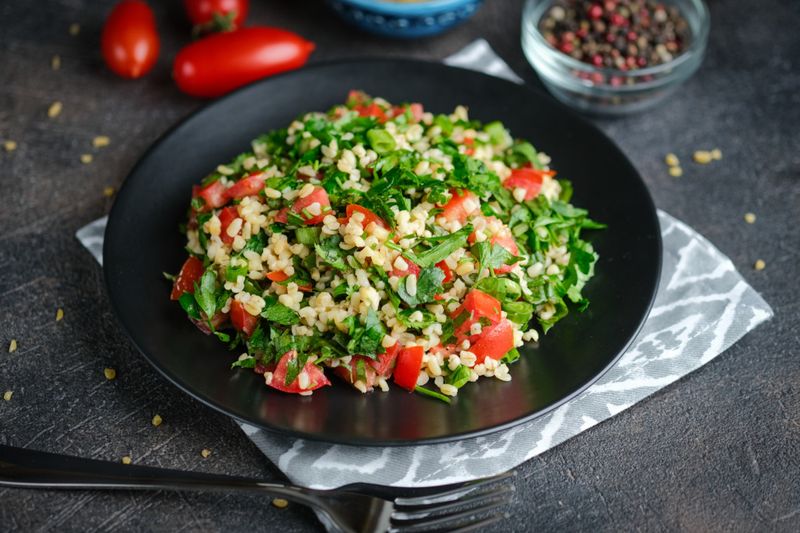
It was an essential part of people’s diets during the Middle Ages. Armenians, Turks and Palestinians have their own versions of tabouleh as well.
Its super delicious and healthy but you need some time to finely chop all the ingredients.
Along with lemon juice, olive oil and salt to taste (depending on the quantity) I like to add some fresh or dried mint.
I also substitute the cracked wheat and use cooked quinoa instead (just a personal preference).
Along with hummus, you can always find tabouleh in my fridge.
Its great guilt-free snack if you get any late-night cravings.
One tip, however, always make sure you have a toothpick handy because the parsley will inevitably get stuck in your teeth!
How I make tabouleh:
There are many proper recipes out there but my way is pretty simple:
-3 bunches of parsely finely chopped
-1/2 onion finely chopped
-3 tomatoes finely chopped
-Salt, lemon juice and olive oil to taste
Vegetarian stuffed grape leaves
It is known as Wara Enab B Zeit in Lebanese dialect. The Turkish word, which is also used by Syrians is Yalanji, which means liar in Turkish.
It is called liar because the customer is fooled because their is no meat inside.

The origins of stuffed vine leaves are unknown.
If they are stuffed with meat and rice they are known as dolme in Iran, dolmedes in Greece, tolma in Armenia, and yabra in Syria.
Inside the vegetarian ones are rice, tomatoes, onions, parsley, lemon juice, olive and salt.
You can cut up some potatoes and line the bottom of your pot so the potatoes absorb all the yummy juices.
This dish also takes a lot of time to make because you have to chop all the ingredients and roll each grape leave one by one.
It is very time consuming, so when I make this, I make it in large quantities to last me for a few days.
Mutabal
For eggplant lovers. This is very similar in appearance and texture to hummus but made entirely out of baked eggplant.
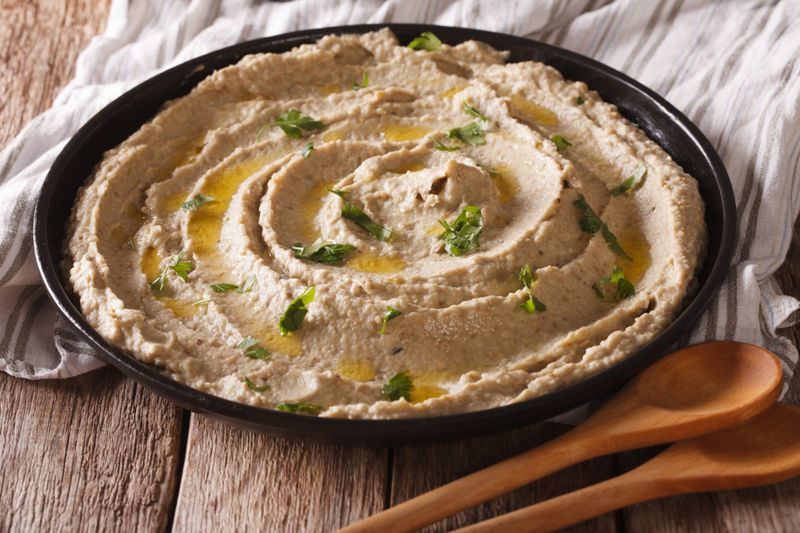
It is an appetizer present on most Levantine mezze tables but its said to come from Lebanon.
How to make it:
To prepare mutabal, grill the eggplant on direct fire to give it a smoky flavour and then blend it in the food processer with lemon, olive oil, tahina, garlic and salt to taste.
You can also roast the eggplant in an oven. Cut the eggplants in long pieces and place them on a baking sheet.
Drizzle with some olive oil and roast for 20-25 minutes at 180 Degrees C.
If you don’t use tahina and add vegetables it is known as Baba Ghanoush.
Fattoush
Fattoush is essentially a “bread salad,” said to have originated in Northern Lebanon.
Lebanese farmers would fry leftover flat bread in a bit of olive oil for extra flavor to throw into the salad.
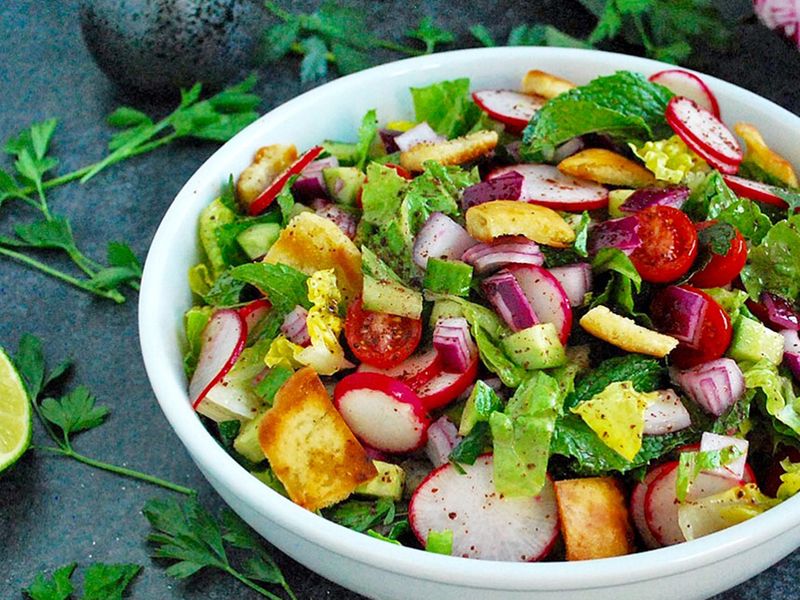
There are many recipes online that have very specific ingredients and methods to prepare the salad but I like my way better.
How I make fattoush:
I chop up lettuce, tomatoes, cucumbers, a bit of onion and radishes (the pieces do not have to be very small). I then add just a handful of parsley, along with lemon juice, olive oil, sumac spice, and a dash of crushed garlic.
I also add just a bit of polmogranite juice to give it an extra zest and sometimes I skip on the flat bread because I want it to be a ‘lighter’ salad.
Mansaf
Mansaf is a traditional Arab dish made of lamb cooked in a sauce of fermented dried yogurt and served with rice or cracked wheat.
It is the national dish of Jordan but can also be found in Palestine, Iraq, Syria and Saudi Arabia.

I would definitely have to say mansaf is an acquired taste and you either love it or hate it.
I am one of those people who do not like it so I have never made it. Hence, I have no recipes to offer.
Couscous
It originated in North Africa and is the traditional dish of the Berbers, an ethnic group, in whose language the name of the dish means “well rolled” or “well formed.”
Couscous is Morocco's national dish.

It is more than just a staple food: for many families, preparing and eating couscous is a ritual and a tradition that binds the families together.
In many ways, couscous is to Morocco, Algeria and Tunisia what pasta is to Italy.
Similar to rice, pasta, or bread, couscous is an inexpensive and highly nutritive product made from wheat or other cereals (barley, sorghum, corn, millet, or minor grains) with the capacity for long-term preservation.
The basic ingredients of the couscous stew are seasonal vegetables and legumes (usually chickpeas), fish or meat and spices. There are regional preferences regarding couscous. Algerian couscous includes tomatoes and a great variety of legumes and vegetables, and Moroccan couscous uses saffron.
Tunisian couscous includes fish and dried fruit recipes and always contains chickpeas and a hot salsa (harissa).
I personally love couscous but I cannot eat it much due to a food intolerannce to specific grains, so I don’t have any recipes to share here.
Kabsa
Kabsa is a rice-based dish known as one of the traditional dishes of Saudi Arabia, but is common in many Gulf countries such as Kuwait, Bahrain and the UAE.

Along with the rice usually is meat, fruits, vegetables, nuts and spices.
The spice mix is responsible for its unique and variant taste.
The spices used are saffron, cinnamon, cardamom, black lime, black pepper, cloves and nutmeg.

















